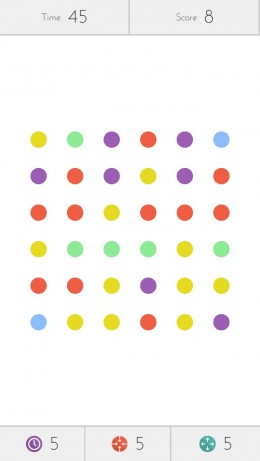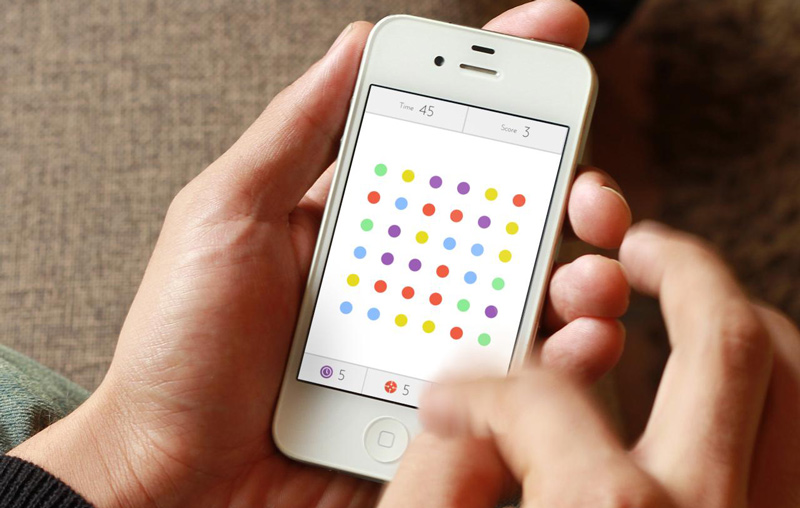 Dots: A Game About Connecting (Free) is what happens when a visual designer plays games like Puzzle Craft and thinks, “I’d really like to do something like that, but I have some ideas on what I’d do differently.” There’s some sort of primal attraction people have to matching things together and watching them disappear, I think, and Dots seeks to get to the root of that, both mechanically and visually.
Dots: A Game About Connecting (Free) is what happens when a visual designer plays games like Puzzle Craft and thinks, “I’d really like to do something like that, but I have some ideas on what I’d do differently.” There’s some sort of primal attraction people have to matching things together and watching them disappear, I think, and Dots seeks to get to the root of that, both mechanically and visually.
The entire game is about connecting two or more same-color dots together, collecting them in the process. You can only do this at 90 degree angles, so diagonals are out. If you make a perfect four-dot square, all dots of that color are collected from the screen. You get 60 seconds per round.
Mechanically, there really isn’t anything new in Dots that people who play puzzle games regularly won’t have seen before. Aside from the matching mechanism, there are three power-ups: One that removes a single dot, one that removes all dots of one color, and one that gives you an extra few seconds on the clock.
 The appeal of Dots is in the execution. From a visual standpoint, the game is incredibly, flawlessly clean. There’s absolutely nothing on the screen that doesn’t need to be there. The dot colors are a pleasant array of pastels. There are even multiple shades of white that suggest the designers took great care to make sure everything matches up well.
The appeal of Dots is in the execution. From a visual standpoint, the game is incredibly, flawlessly clean. There’s absolutely nothing on the screen that doesn’t need to be there. The dot colors are a pleasant array of pastels. There are even multiple shades of white that suggest the designers took great care to make sure everything matches up well.
In terms of audio, the game has all the right sounds going on. The clicking on the menus and in the final seconds of a round is deliciously satisfying. When you make chains, the sound of connecting dots goes up in pitch, giving you a flawless audio cue on how well you’re doing. Overall, the sensory appeal of the game is just lovely through and through. I think most of my satisfaction in Dots was because I was so enamored by the audio-visual presentation.
That is where the positive experience began to taper off, however. While the visuals and audio are great, the game parts of Dots are somewhat hamstringed. Since you can only make 90 degree connections, you’re severely limited in the moves you can make. Sometimes you can only connect 2-3 dots at a time. This is only a problem because making a perfect square is ridiculously unbalanced compared with any other move you could make. Once you get the hang of the basic moves, you realize that the entire game revolves around making squares, as any other strategy will just leave with a lackluster score
The odd part about that is that Dots is all about score. Your score is also your currency, so if you get 250 dots in a round you actually earn 250 dots to spend. You use these to buy those single dot eliminator, full color eliminator, and time extend power ups. Since success hinges heavily upon making perfect squares, you’ll reach a point where you realize how important power-ups are, completing the cycle. You play the game to get dots, you use dots to get power-ups, and you spend the power-ups to get more dots. It becomes an endless dystopian vacuum. Once I became aware of that, the serene, simplified visuals became a little more sinister to me, promising peacefulness and instead simply seeking to lure me into their clutches.
This is where I should mention that you can also buy dots as an in-app purchase. Dots is free, so this is the only way the developer is making money. That tells me that the goal of the game is to teach you the mechanics, then suck you into this endless feedback loop in hopes that you’ll spend money when you figure out that you’re woefully unprepared without power-ups. I feel like I would have enjoyed Dots a lot more if I had just paid a few dollars for it and not had the option to purchase in-game currency. It just seems like a shoehorned monetization technique and I thought it marred the overall feeling of the game.
Dots is somewhat lacking in terms of mechanical meat, but it’s still an audio-visual treat that sets a high standard for game presentation. I would recommend it to anyone who likes puzzle games and wants a few minutes of entertainment here and there, especially since the full game is free, but with the caveat that you should beware getting sucked into the endless in-app purchase black hole.

